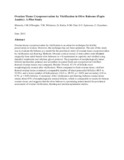| dc.description.abstract | Ovarian tissue cryopreservation by vitrification is an attractive technique for fertility preservation in women. However, this technique has not been optimized. The aim of this study was to evaluate the baboon as a model for the preclinical study of ovarian tissue cryopreservation by vitrification and thawing. Methods: Ovarian cortical tissues (1-mm cubes) were obtained surgically from adult female olive baboons (n = 9) maintained in captivity and vitrified using dimethyl sulphoxide and ethylene glycol protocol. The proportion of morphologically intact follicles (primordial, primary and secondary) in paired fresh and cryopreserved (vitrified-thawed) ovarian tissues was compared. Results: Overall, 67.1% of follicles were morphologically normal after vitrification. When compared to fresh ovarian tissue, vitrified-thawed ovarian tissue contained a comparable number of intact primordial follicles (48.9 vs. 52.9%), and a lower number of both primary (14.8 vs. 29.5%; p < 0.05) and secondary (2.0 vs. 0.7%; p < 0.05) follicles. Conclusion: After vitrification and thawing, baboon ovarian tissue retains about 67% of morphologically normal follicles, which is comparable to results for human ovarian tissue, and suggests that the olive baboon is a promising animal model for preclinical assessment of ovarian vitrification, thawing and autotransplantation studies. | en |

